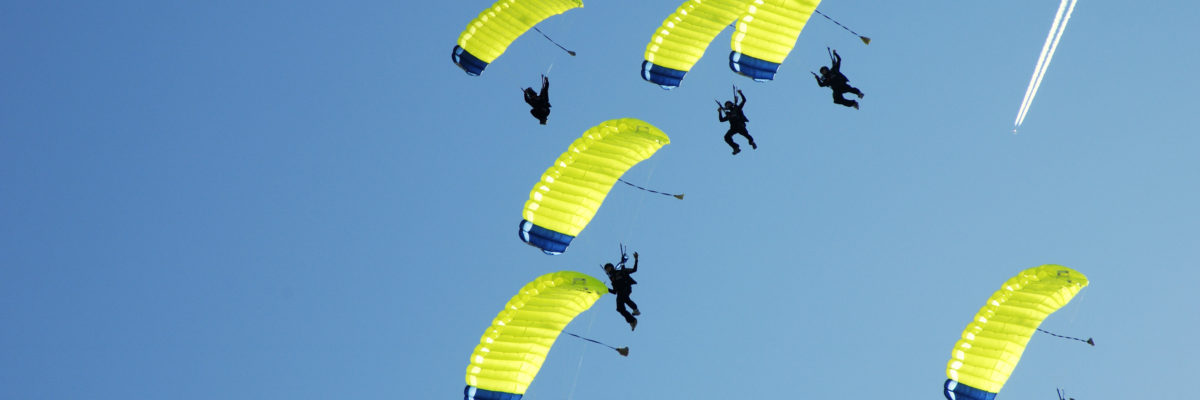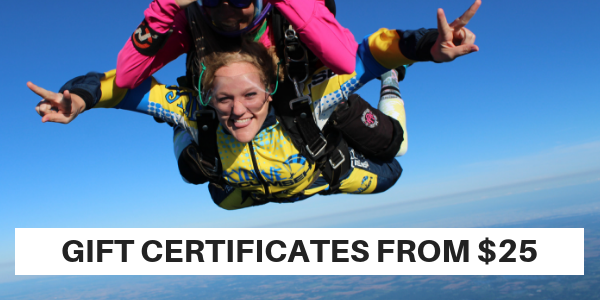- Michigan's Premier Skydiving Center
- Call Now: (517) 423-7720

How To Buy Used Skydiving Gear
Thursday, June 29, 2017
- Skydive Tecumseh
- 6/29/17
- 0
- General
Now that you’re a card-carrying member of the skydiving community, it might be verrrrrry tempting to run out and get measured for the shiniest custom gear you can find. That, however, is a bad idea–in much the same way that brand-new drivers shouldn’t run out and buy a brand-new car. Once you lay down a bunch of miles on the skydiving road, you’ll know exactly what you want, and you can get that tie-dye container in your colors; until then, the very best idea is to make do with high-quality used skydiving gear. Trust us on this.
If you know that already, you might think that you’re going to have to shell out for rental gear in the meantime. Though the per-jump or per-day pricing might not seem like a huge amount at the outset, over time you’ll find that it’s much more economical to buy your first set of essential skydiving gear than to continue renting.
Without further ado, let’s get started. Here’s a quick shopping list of essential skydiving equipment:
- Main Canopy
- Reserve Canopy
- Container System
- AAD (Automatic Activation Device)
Where’s the rest of the stuff, you ask? Well: You don’t need to buy skydiving goggles, an altimeter, or a skydiving helmet* at the outset, as you can usually borrow those items from the dropzone, or rent at a very low cost, while you’re waiting for your cash reserves to refill.
How to Buy a Used Harness/Container System
If you don’t take any of the rest of our advice, take this: Do not look for a skydiving container first. There are OH SO MANY reasons why. The heart of the matter is this: You have to know the exact sizes of both of your skydiving parachutes before you can buy a container to fit them, which means that this is definitely not a chicken-or-egg question.
Once you’ve picked your parachutes, you can choose a container. First, though, you have to get one more thing measured: yourself. Have a rigger do it; he or she will know best how.
Once you’ve identified a container that seems like it will fit, ask the seller for its serial number, then contact the manufacturer who made that container. Tell them the measurements that the rigger took, and ask if the container identified by that serial number is a good fit for both your body and your parachutes.
How to Buy a Used Main Skydiving Canopy
Your first job is to figure out your wing loading. This is a captivating subject in and of itself, and we suggest that you look at the sizing chart developed by the inimitable Brian Germain in order to find your optimum wing loading at this time.
From there, look at the used parachutes for sale that sit within that size range. Your goal is to identify an undamaged, unrepaired main canopy with as few jumps on it as you can afford. Canopies with fewer jumps are less porous, so they fly better–and land better–than older ones. Within those canopies, try to choose one that has been jumped seasonally at big, grassy dropzones (like ours!), where you won’t have to worry as much about damage from desert dust or ocean spray.
How to Buy a Used Reserve Parachute
If it’s in great shape, there are a few easier places to bring down your total parachute cost than buying a used backup parachute. Just ask any rigger–they’re the experts, and they generally concur that buying a brand-new skydiving parachute backup isn’t worth it.
Of course, you will want to be sure (with the inspection of a rigger) that there is no previous damage and no patches. A reserve parachute with no “rides” is ideal; you certainly don’t want one with more than ten. Age counts here, too: If your reserve is old enough to vote, it’s too old to jump.
How to Buy a Used AAD
First of all: do buy an AAD. This is not an “optional” thing. The fact that most skydivers have and use automatic activation devices is one of the reasons that modern skydiving suffers so few fatalities–and this is not a situation in which you want to be the exception that proves the rule.
Luckily, buying a used AAD is simple. AADs have an expiration date and you’ll be paying, essentially, a fixed cost per year of service. So just make sure that the AAD you choose is either a CYPRES or a Vigil, that it’s within its service life, that the proper maintenance schedule has been met, and that the device in question is approved for your container system. Buy new, if you can fork over the cash upfront. AADs are very very easy to resell.
Mind The Three Laws
We know that’s already a lot but stay with us for just one more moment. We’ll leave you with three rules that you need to follow when you’re buying used skydiving equipment:
Keep an open mind! At this stage of the game, you’re not going to find your perfect kit in your perfect colors at a low cost. Take a deep breath and know that you’ll get there eventually.
But cover your butt. Pay an expert–specifically, a professional rigger–to inspect anything you buy before you buy it. It’s not expensive, and it’s insurance. As part of the deal, ask the rigger to write down a list of issues, both actual and potential, along with the cost to remedy each one.
Finally, trust your gut. Don’t like the flare? Uncomfortable chest strap? Flappy-flappy reserve flap? Simple not sure about something? Do yourself a favor. Don’t buy it. You won’t ever be happy with it, and starting out with gear you don’t like to fly will have a deleterious backlash that could affect your entire skydiving career…and we want to share the sky with you for a long, awesome time!
*Open-face skydiving helmets are just skating/snowboarding helmets anyway, really.
Copyright © 2024, Skydive Tecumseh, All Rights Reserved.
DropZone Web Design & Marketing by Beyond Marketing, LLC
